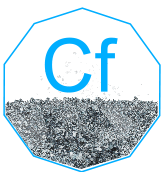Californium

Californium (Cf)
General Information
- Symbol: Cf
- Atomic Number: 98
- Atomic Weight: 251 u
- Element Category: Actinide
- Group: N/A (Actinides series)
- Period: 7
- Block: f-block
Physical Properties
- Appearance: Silvery-white metallic, tarnishes slowly in air
- Density: 15.1 g/cm³
- Melting Point: 900 °C (1652 °F)
- Boiling Point: Estimated around 1745 °C (3173 °F)
- Phase at STP: Solid
- Electron Configuration: [Rn] 5f¹⁰ 7s²
- Oxidation States: +3 (most common), +2, +4
Chemical Properties
- Reactivity: Californium is reactive, especially in the +3 oxidation state. It reacts with oxygen, steam, and acids.
- Compounds: Forms compounds such as californium dioxide (CfO₂), californium(III) chloride (CfCl₃), and californium(III) nitrate (Cf(NO₃)₃).
Uses and Applications
- Neutron Sources: Californium-252 is widely used as a neutron source in neutron radiography, neutron activation analysis, and in nuclear reactors for starting up reactors.
- Medical Applications: Used in certain types of cancer treatment for its neutron-emitting properties.
- Research: Used in scientific research, particularly in the study of heavier transuranium elements.
Occurrence and Extraction
- Natural Occurrence: Californium does not occur naturally and is a synthetic element.
- Production: Produced in nuclear reactors or particle accelerators by bombarding curium or plutonium with neutrons.
Isotopes
- Stable Isotopes: Californium has no stable isotopes.
- Radioactive Isotopes: The most significant isotopes are Californium-252 (half-life of 2.645 years), Californium-249 (half-life of 351 years), and Californium-250 (half-life of 13.08 years).
Safety and Handling
- Hazards: Californium is highly radioactive and poses significant health risks. It can cause radiation poisoning and cancer if inhaled or ingested.
- Precautions: Handle with extreme care, using appropriate protective equipment and working in controlled environments. Proper disposal of radioactive materials is crucial.
History
- Discovery: Discovered by Stanley G. Thompson, Glenn T. Seaborg, Kenneth Street, and Albert Ghiorso in 1950.
- Name Origin: Named after the state of California and the University of California, Berkeley, where it was discovered.
Additional Facts
- Crystal Structure: Double hexagonal close-packed (dhcp)
- Magnetic Properties: Paramagnetic
- Thermal Conductivity: Estimated around 10 W/m·K
- Electrical Resistivity: 0.16 µΩ·m at 0°C
Summary
Californium is a synthetic element known for its use as a neutron source in various applications, including neutron radiography, cancer treatment, and scientific research. Discovered in 1950, it is produced in nuclear reactors or particle accelerators and requires careful handling due to its high radioactivity.
40 Question and Answer Pairs About Californium
What is the atomic number of Californium?
- 98
What is the symbol for Californium?
- Cf
What is the atomic weight of Californium?
- 251 u
In which group of the periodic table is Californium found?
- Actinides series (no specific group)
What period is Californium in?
- Period 7
What block does Californium belong to?
- f-block
What is the density of Californium?
- 15.1 g/cm³
What is the melting point of Californium?
- 900 °C (1652 °F)
What is the boiling point of Californium?
- Estimated around 1745 °C (3173 °F)
What is the electron configuration of Californium?
- [Rn] 5f¹⁰ 7s²
What are the common oxidation states of Californium?
- +3 (most common), +2, +4
What is the appearance of Californium?
- Silvery-white metallic
Is Californium reactive with air?
- Yes, it tarnishes slowly.
Name a compound of Californium.
- Californium dioxide (CfO₂)
What is a common use of Californium-252?
- Used as a neutron source in neutron radiography.
How is Californium used in medical applications?
- Used in cancer treatment for its neutron-emitting properties.
What role does Californium play in scientific research?
- Used to study heavier transuranium elements.
How is Californium typically produced?
- By bombarding curium or plutonium with neutrons in nuclear reactors or particle accelerators.
What is the most common isotope of Californium for neutron sources?
- Californium-252
How is Californium extracted?
- Produced synthetically in nuclear reactors or particle accelerators.
What safety hazard is associated with Californium dust?
- It is highly radioactive and poses significant health risks.
Who discovered Californium?
- Stanley G. Thompson, Glenn T. Seaborg, Kenneth Street, and Albert Ghiorso
Where does the name Californium come from?
- Named after the state of California and the University of California, Berkeley.
What is the crystal structure of Californium at room temperature?
- Double hexagonal close-packed (dhcp)
Is Californium paramagnetic or diamagnetic at room temperature?
- Paramagnetic
What is the thermal conductivity of Californium?
- Estimated around 10 W/m·K
What is the electrical resistivity of Californium at 0°C?
- 0.16 µΩ·m
What is the primary oxidation state of Californium in its compounds?
- +3
Is Californium found as a free element in nature?
- No, it is a synthetic element.
What is the common name of Californium(III) chloride?
- CfCl₃
What is a major application of Californium in neutron sources?
- Used in neutron radiography and neutron activation analysis.
How does Californium benefit medical treatment?
- Used in certain cancer treatments due to its neutron emission.
What is the melting point of Californium in Kelvin?
- 1173 K
What group does Californium belong to in the periodic table?
- Actinides series
What is the natural abundance of Californium-252?
- It is produced synthetically and is not found naturally.
Can Californium be used in high-temperature applications?
- Yes, particularly in neutron sources.
What is the key property that makes Californium valuable in neutron sources?
- Its ability to emit neutrons.
How is Californium used in the chemical industry?
- Mainly in research and specialized applications.
What precautions should be taken when handling Californium?
- Use appropriate protective equipment to avoid inhalation or ingestion.
What are the health risks associated with Californium?
- It can cause radiation poisoning and cancer if inhaled or ingested.






